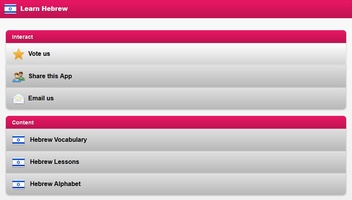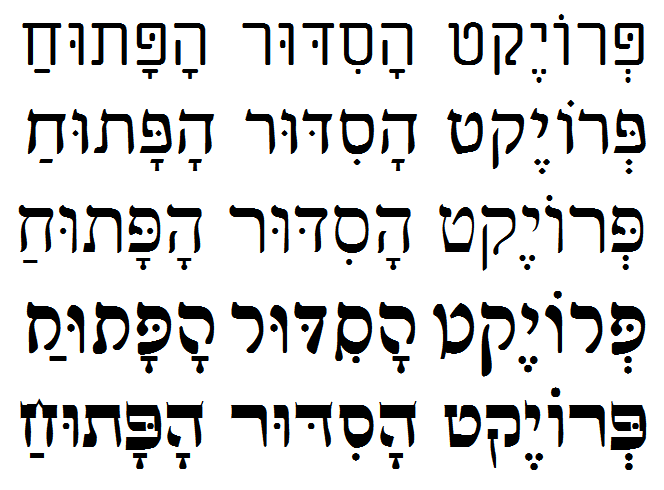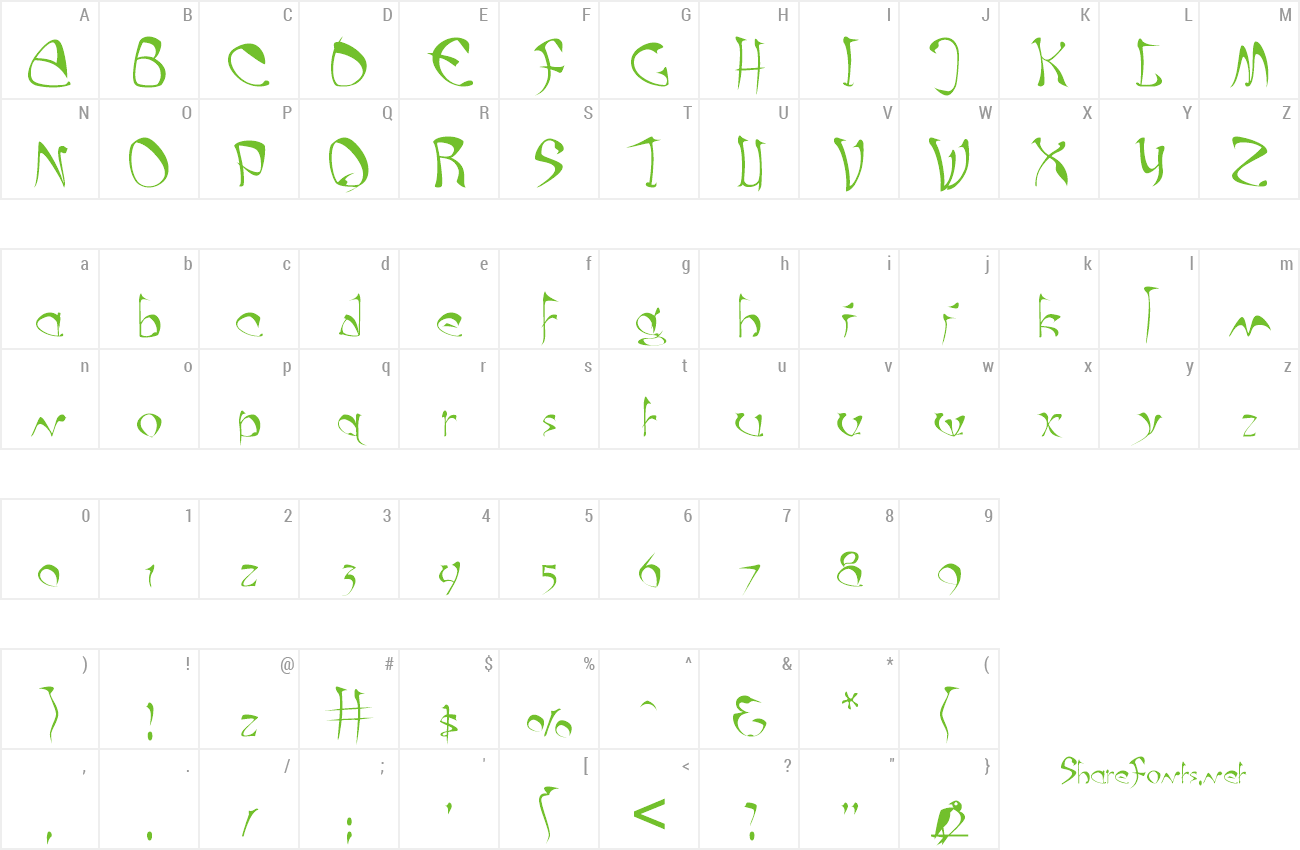With the help of this mod, however, you're sure to find a font that's right for you. Samsung's Galaxy Store has fonts that you can install. The problem is, many of them aren't free, averaging around $1.79 per font. But Galaxy users on One UI 2.0, aka Android 10, have another option. This font was created using FontCreator 6.5 from High-Logic.com. Accordance Font. The Accordance Font is a new Unicode font which combines various biblically related fonts used within Accordance into a single Unicode font for clean, beautiful, and accurate display of a wide variety of ancient content. It can be used in any Unicode capable application on any platform, and is recommended for the display of.
- Hebrew Font For Android Emulator
- Hebrew Font For Android
- Hebrew Font App For Android
- Download Hebrew Font For Android
| Category | Sans-serif, Serif, Monospace |
|---|---|
| Designer(s) | Steve Matteson |
| Foundry | Ascender Corp. |
| Date released | 2008 |
| License | Apache License |
| Sample | |
Hebrew Font For Android Emulator
Droid is a font family first released in 2007 and created by Ascender Corporation for use by the Open Handset Alliance platform Android[1] and licensed under the Apache License. The fonts are intended for use on the small screens of mobile handsets and were designed by Steve Matteson of Ascender Corporation. The name was derived from the Open Handset Alliance platform named Android.
Examples[edit]
Droid Serif
Droid Sans*
Droid Sans Mono
* Unlike other sans fonts, the capital letter I retains its serifs.
Typefaces[edit]
The Droid font family consists of Droid Sans, Droid Sans Mono and Droid Serif:
- The Droid Sans typeface consists of Regular and Bold fonts. Droid Sans regular font includes support for Simplified and Traditional Chinese, Japanese, Korean, Arabic, Armenian, Ethiopic, Georgian, Hebrew, and Thai support for the GB2312, Big 5, JIS X0208 and KSC 5601 character sets respectively which the design style for all the Ideographs are using the Simplified Chinese writing style. There is no italic variant of Droid Sans; however, it is present in its derivative, the very similar Open Sans. Known variations include:
- Droid Sans Arabic [Regular] available from Google Fonts API
- Droid Sans Armenian [Bold and Regular] available from Google Fonts API
- Droid Sans Devanagari [Regular] available from Google Fonts API
- Droid Sans Georgian [Regular] available from Google Fonts API
- Droid Sans Hangul [Regular] available from Google Code
- Droid Sans Hebrew [Bold and Regular] available from Google Fonts API
- Droid Sans Japanese [Regular] available from Google Fonts API or Github
- Droid Sans SEMC [Regular] available from Nokia Website
- Droid Sans SEMC CJK [Regular] available from HTC website
- Droid Sans Subset [Bold and Regular] embedded font in Google Docs
- Droid Sans Tamil [Bold and Regular] available from Google Fonts API
- Droid Sans Thai [Regular] available from Google Fonts API
- Droid Sans Fallback font could be found on other language rich websites, especially those with Hindi or Khmer language support, are listed below:
- Droid Sans Fallback Full [Regular] available from Google Fonts API
- Droid Sans Fallback Fan Dal [Regular] available from Google Code China
- Droid Sans Fallback HTC [Regular] available from HTC website
- Droid Sans Fallback Indic [Regular] font support for Hindi, Devanagari, Kannada, Bengali, Oriya, Malayalam, Telugu, Tamil and Punjabi languages
- Droid Sans Fallback Khmer [Regular] font support for the Khmer language
- Droid Sans Fallback Legacy [Regular] available from Google Fonts API
- Droid Sans Fallback QVGA [Regular] font support for old VGA based systems
- Designed by Steve Matteson and Terrance Weinzierl of Monotype Imaging, Droid Sans Mono consists of only the Regular font. The design is similar to Matteson's closed source Andalé Mono typeface design. Taking advantage of the license under which the original typefaces were released, modifications of this Droid Sans Mono have appeared on the internet. Of particular note are those modifications that replace the plain zero glyph with dotted or slashed versions. Such modifications are particularly desired by users making heavy use of monospaced typefaces, including software developers, because they provide a more prominent differentiation between the two characters. They include:
- Droid Sans Mono Dotted [with dotted zeros]
- Droid Sans Mono Slashed [with slashed zeros]
- Droid Sans Mono Py [adapted for the Python programming language, with adjacent underscores separated][2]
Hebrew Font For Android


- The Droid Serif typeface consists of Regular, Bold, Italic and Bold Italic fonts. Other variations of the Droid Serif font includes:
- Droid Serif Subset [Regular] embedded font in Google Docs
- Droid Serif Thai [Bold and Regular] available from Google Fonts API
Each typeface has an extensive character set including coverage of Western European, Eastern/Central European, Baltic, Cyrillic, Greek and Turkish languages.
Droid Pro (2009)[edit]
On 12 February 2009, Ascender Corporation announced the retail version of the Droid fonts under the Droid Pro family. The fonts were sold in OpenType and TrueType font format. The planned Droid Pro family consists of Droid Sans Pro (Regular, Bold), Droid Sans Pro Condensed (Regular, Bold), Droid Sans Pro Mono (Regular, Bold), Droid Serif Pro (Regular, Italic, Bold, Bold Italic), Droid Sans Fallback. Initial releases include Droid Sans Pro, Droid Serif Pro. OpenType features include Old Style Figures. Droid Sans Pro Mono went on sale beginning in 2009-07-31.
Handset Condensed (2010):Handset Condensed is a condensed version of Droid Sans Pro designed by Ascender Corp's Steve Matteson released on 1 March 2013 to be compatible with the Droid family of fonts, but without OpenType features. Similar to Droid Sans Pro, the family includes 2 fonts in Bold and Regular weights without italics. It supports the WGL character set.
Droid Arabic Kufi and Droid Arabic Naskh[edit]
In 2009, Ascender Corporation designed specially customed fonts for Google Fonts API as language support for the Arabic and Persian languages. The fonts that were released are available at the Google Fonts website and are Droid Arabic Naskh [both Bold and Regular weights] and Droid Arabic Kufi [both Bold and Regular weights]. Other variations that were found until recently includes the Droid Persian Naskh, a specific font for the Persian Farsi language distributed by Open Font Library in May 2014.
Special Droid typefaces in Android phones[edit]
It has been found that in some Android smartphones that operate under the Android 4.2 Jellybean OS that the following fonts have been found in the Fonts folder in the phone's rooted 'systems' folder. The fonts include:
Hebrew Font App For Android
- Droid Naskh Shift Alt [a font found only in Android phones supporting the Arabic, Urdu, Uighur and Farsi languages]
- Droid Naskh Shift [a font found only in Android phones supporting the Arabic, Urdu, Uighur and Farsi language calligraphies]
- Droid Naskh System UI [a system font found only in Android phones supporting the Arabic and Farsi languages]
- Droid Naskh UI [a system font found only in Android phones supporting the Arabic and Farsi language calligraphies]
Other variations of the Droid font that aimed to depict the Android 'robot' image logo include [Droid Robot Regular font] and [Droid Robot Japanese Regular font - for Japanese language support]. Aims by specific language font designers to adapt fonts for particular Southern Asian languages include Droid Hindi [support for the Hindi language], Droid Telugu [support for the Telugu language] and Droid India [support for the Indian languages all over India]. These fonts could be found on Github or in the XDA Developers forum for Android smartphones.
See also[edit]
Download Hebrew Font For Android
- Roboto, the default font for newer versions of Android
- Noto, the default fallback font for newer versions of Android
References[edit]
- ^Woyke, Elizabeth (26 September 2008). 'Android's Very Own Font'. Forbes. Retrieved 22 February 2012.
- ^'droid-sans-mono-py'. code.google.com. Google Code Archive - Long-term storage for Google Code Project Hosting.
External links[edit]
| Wikimedia Commons has media related to Droid fonts. |
- 29arabicletters page: Droid Naskh (custom)Droid Naskh (retail)
- Google Web Fonts page: Droid Naskh, thai-droidsans

- Download:
- Install HTC Sync from your HTC device
- Connect device to computer using USB cable.
- Mount the SD card from the HTC Alerts Menu (Drag from the top of the screen).
- Install the sync application from the newly discovered drive in Windows.
- Extract the three zip files into some folder (separate folders for each zip).
- Go to the Android SDK folder and open the tools folder.
- Copy the two files from the boot image zip (1.b) into the tools folder:
- boot.img.insecure
- boot.img
- Shutdown the phone.
- Press and hold the back key and power on the phone.
This is get you into the fastboot screen (the white screen with three androids at the bottom). - Connect the phone to the USB cable if it’s unplugged.
- On Windows, open cmd.exe (Start àRun à cmd.exe à Enter):
- Change the directory to the tools directory you’ve created earlier.
Output:
- Now your device will start from the given image with root access.
- Install the fonts
- Once the phone has loaded, repeat the steps in 2.b to mount the SD card in Windows.
- Copy the font files from the zip file (1.c) to the SD card’s root folder.
- From the phone’s alerts menu, unmount the SD card.
- Gain root access:
- In the phone’s alerts menu, click HTC Sync. This will popup the HTC Sync tool in Windows. Ignore it!
Output:
#- From the prompt you got (#) run the following command to mount the phone’s file system in RW mode:
- Install the fonts on the phone (when you run each command the output will be the command itself):
- Backup the original font files by running the following commands in the shell (#) – Run each command separately (don’t just copy-paste all the lines!):
- Copy the new font files from the SD card into the phones ROM:
- The phone will restart and load the original Android ROM.
- Enjoy the Hebrew!
- To install the Hebrew keyboard follow this guide:
http://code.google.com/p/softkeyboard/wiki/HowTo
Thanks To : adq from the xde forum for the rooting info.
Comments are closed.